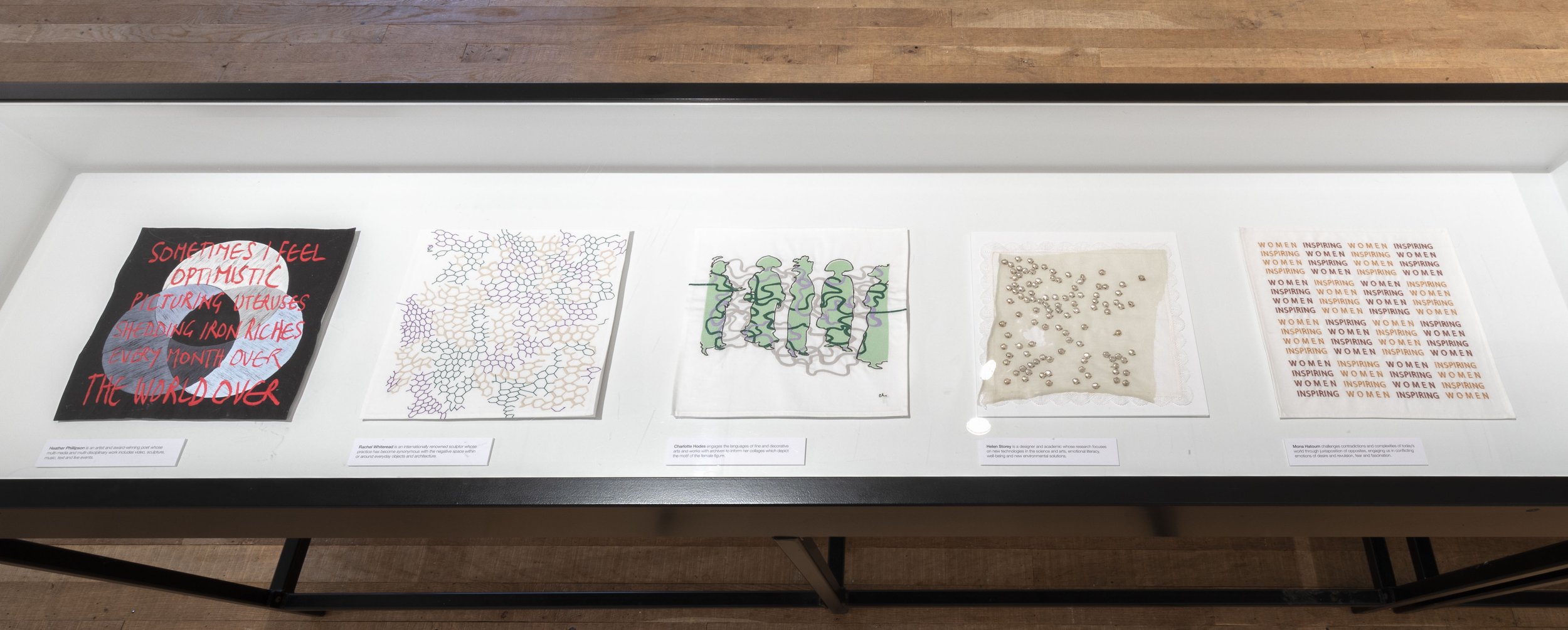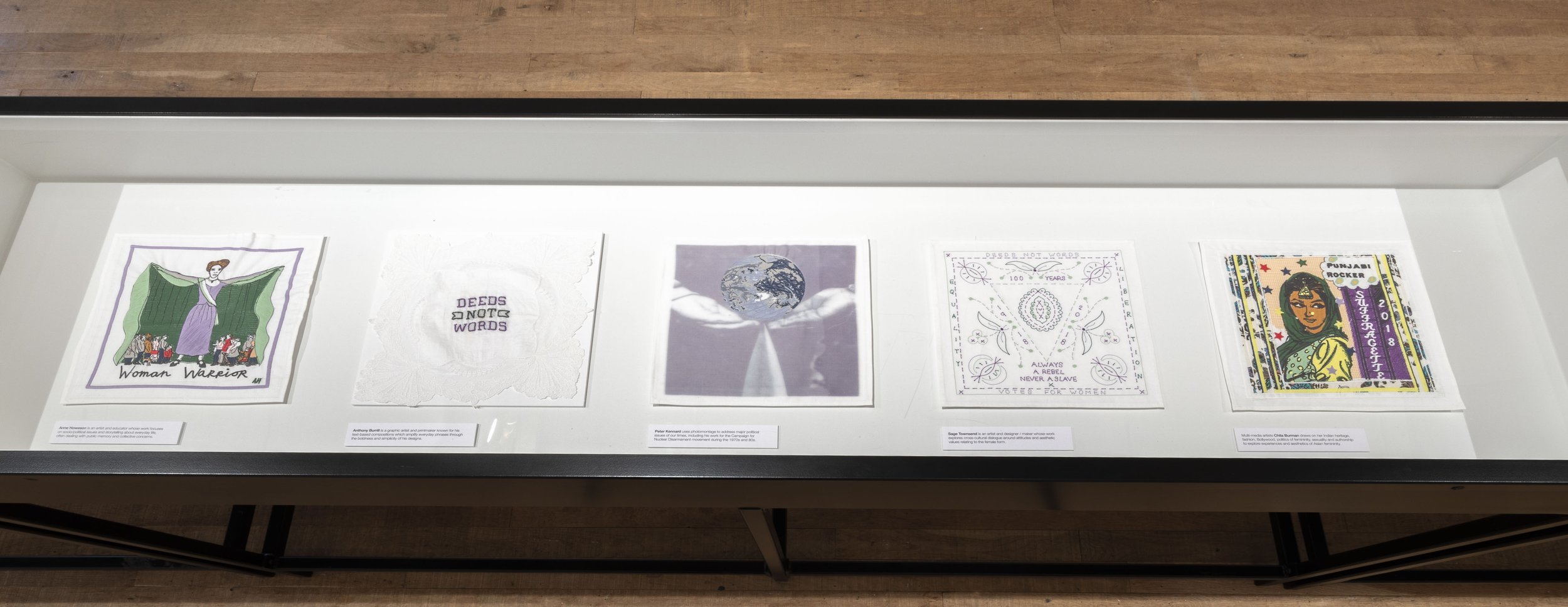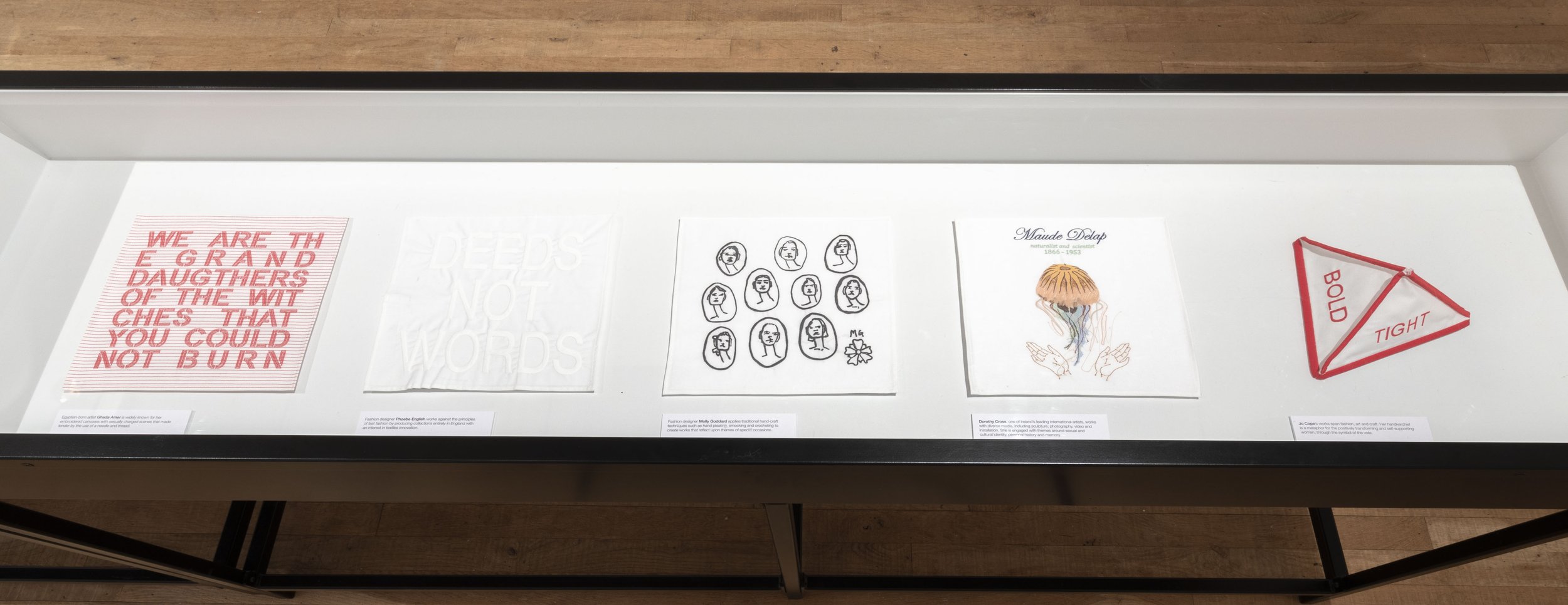The Power of A Needle and Thread: Motive / Motif at Ruthin Craft Centre
Suffragette Handkerchief, 1912. Priest House Museum, Sussex Archaeological Society
There are not many situations today in which we have the chance to write our signature. By this, I am not referring to when you quickly scribble your initials on a receipt, sign your name in messy cursive on a new bank card, or add your e-signature to an online petition. I mean the act of physically writing out your name, consciously going over every line and curve of each letter with purpose. There is power in a signature and the act of affixing it to something you want to be connected to, that you want to be remembered for, seems to be lost in our contemporary society.
The project Motive / Motif, currently on display at Ruthin Craft Centre in North Wales, is centred around the Suffragette Handkerchief: a linen handkerchief embroidered with the signatures of sixty-eight women who had been imprisoned in HMP Holloway in March 1912. Most of the women whose names appear on the cloth were involved in demonstrations organised by the Women’s Social & Political Union in the same month. The suffragettes were denied political prisoner status in Holloway Prison and thus were held in much harsher conditions, leading them to stage hunger strikes and many women being force-fed as a result.
It is not known if the names on the handkerchief were stitched by each individual signer or by a select few on behalf of all, but what is clear is the collective motive for embroidering their names on this now historic cloth. Centred at the bottom of the handkerchief, “Votes for Women'', along with the location and date, is stitched in the suffragette colours of purple and green. With these words and the sixty-eight signatures, this ordinary domestic object transforms into a canvas of political expression. It was a visual reminder of the movement to those outside it, as well as something that could unite these imprisoned women.
Installation view of Motive/Motif: Artists Commemorate the Suffragettes, Ruthin Craft Centre, 2023.
Exhibition curators Charlotte Hodes and Alison Moloney were inspired by this historic object to organise the project Motive / Motif: Artists Commemorate the Suffragettes in 2018 at the London College of Fashion to mark 100 years since the passing of the 1918 Representation of the People Act. Hodes and Moloney commissioned twenty artists to create their own works using the same format of a 28 x 28 cm handkerchief. The list of artists demonstrates the project’s scope to engage a plethora of voices. These include more established names such as Sarah Lucas, Chila Burman, Mona Hatoum, Ghada Amer, Dorothy Cross, Rachel Whiteread, and Peter Kennard, to recent LCF alumni Jo Cope, Molly Goddard and Daniel Ramos, as well as designers and makers like Phoebe English, Sage Townsend and Francesca Smith. The resulting collection of works reflects this wide range of backgrounds in the diversity of approaches to the handkerchief surface.
Key highlights include Heather Phillipson’s contribution of a black handkerchief with overlapping circles made from densely stitched threads in varying shades of grey. At the centre of the circles, an opening is revealed, forming a womb-like configuration that mirrors the mystical power of poetic text placed above.
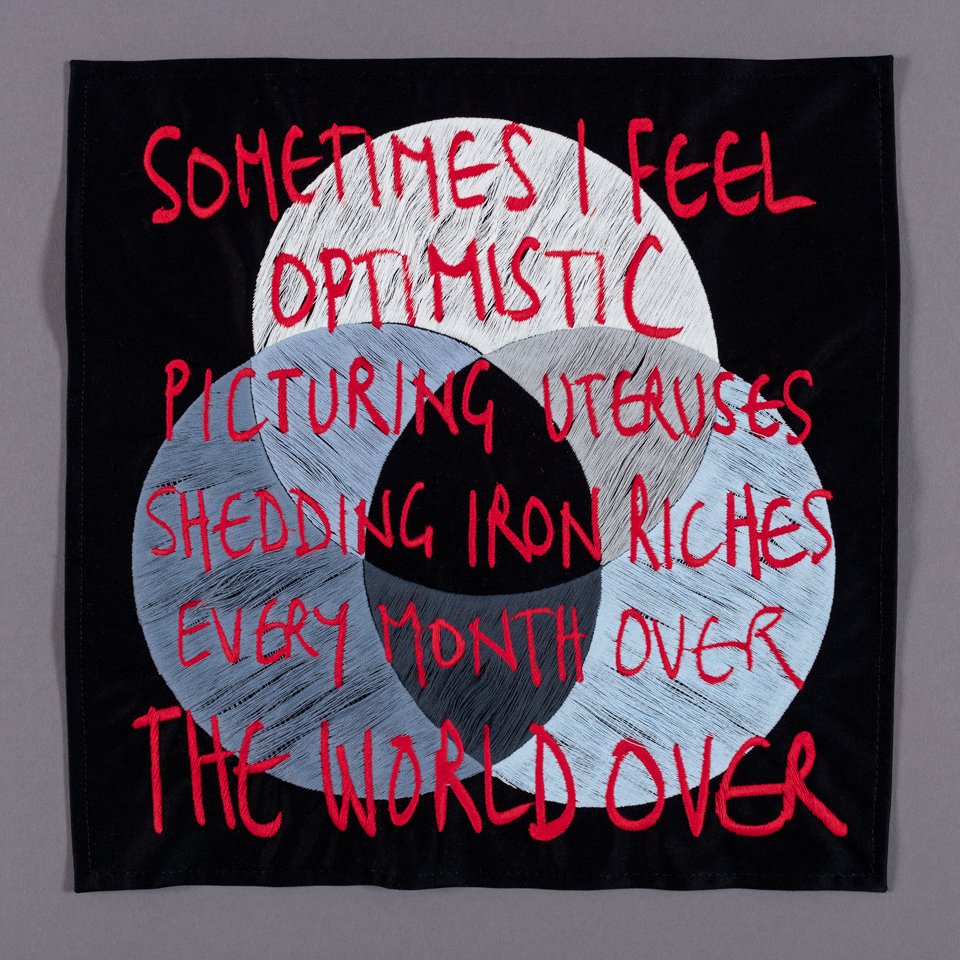
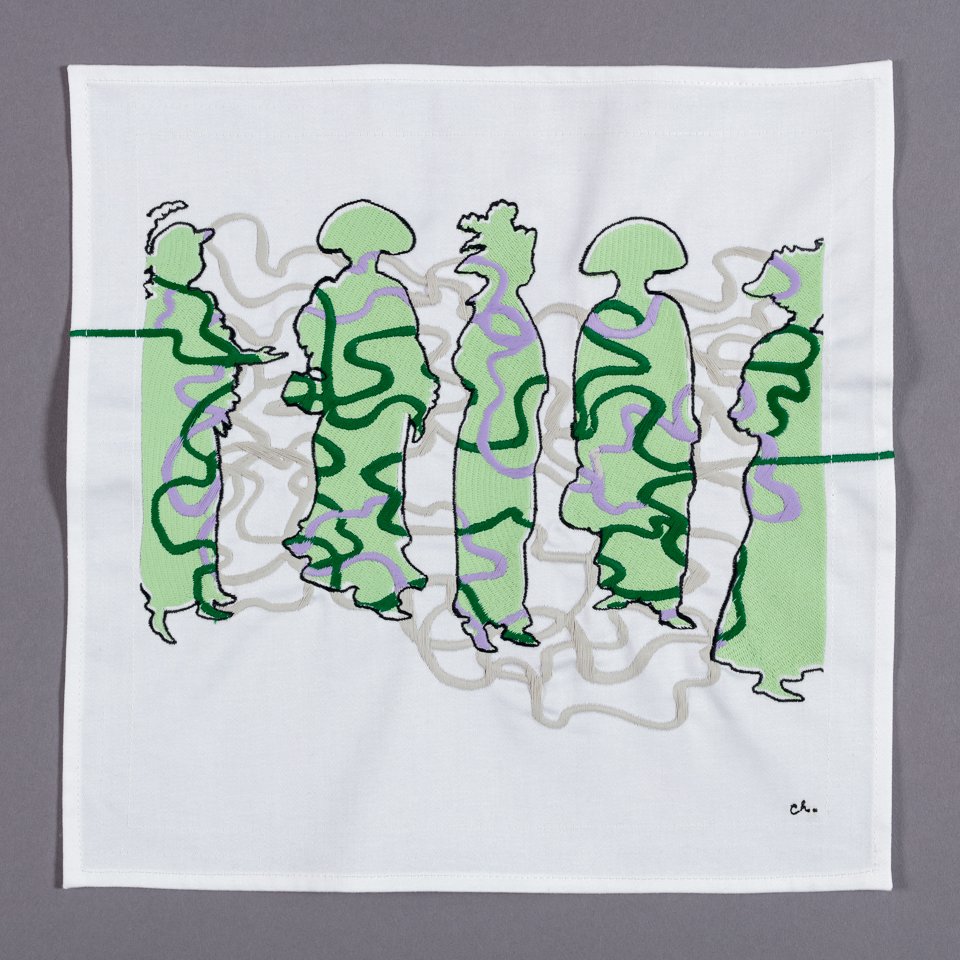
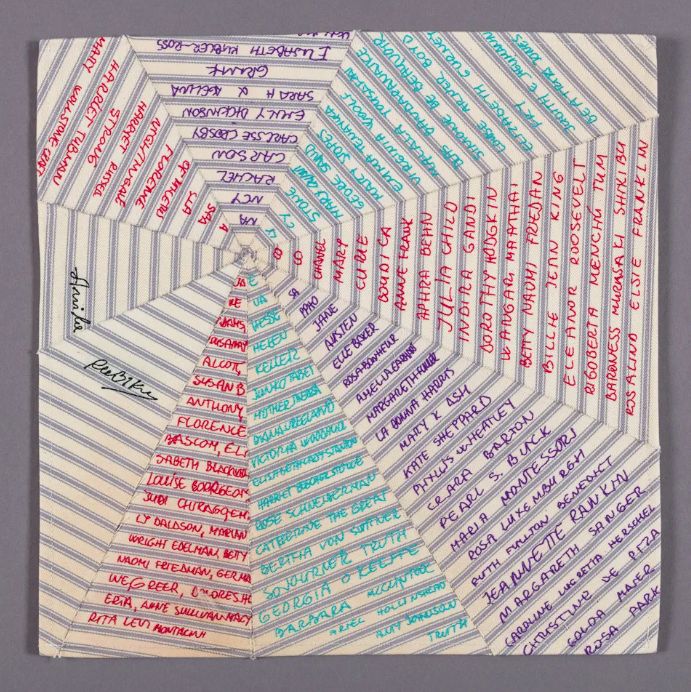
Charlotte Hodes’s piece presents outlined silhouettes of suffragettes parading across the cotton cloth’s surface. Despite their individual features being removed, the figure’s early-twentieth century fashion is still evident from the shapes of their broad brimmed hats and flowing petticoats, as seen in the few photographs we have from suffragette protests. The green, purple and cream threads that swim across and in between the figures allude to the cause that tied them together, as well as their place within the wider history of universal suffrage.
Anila Rubiku creates a web with names of famous women across history and disciplines – such as Betty Friedman, Sojourner Truth and Indira Gandhi – between lines of repurposed fabric, split into sections and stitched back together to create a fragmented handkerchief. Anthony Burrill and Helen Storey use vintage handkerchiefs with intricate lace borders and both work within the original fabric’s pattern to incorporate their own respective images, in contrast to the clean, white and untouched surface of the modern handkerchiefs used by other artists for this project. Text is a prominent element across the different pieces, with many artists employing in their designs the famous suffragette slogan of “Deeds not Words' or quotes such as “Women Inspiring Women”, as seen in Mona Hatoum’s piece which repeats this phrase in alternating red and orange threads and forms a checkerboard pattern. Through their use of text and the figurative, the commissioned artists thread between direct references to the suffragette movement and contemporary conversations around the feminist movement, gender equality, and reproductive rights.
Though a design element that might be easy to overlook, the display cases at Ruthin Craft Centre allow the viewer to carefully inspect each embroidered work. The contemporary handkerchiefs are shown in cases that were specifically designed to present the handkerchiefs at the LCF exhibition. The handkerchiefs are placed with enough space between them so that they can be appreciated both as singular objects and as part of a larger grouping, which accentuates the tactility of the textiles pieces. The density of the stitching, how the embroidery pulls the linen taut, the fabric refusing to lay perfectly flat: all of these details would be difficult to discern if the pieces were individually framed and hung on the wall.
The project’s latest presentation at Ruthin Craft Centre is the first time it has been displayed in Wales and is the first time the handkerchiefs are accompanied by three banners made for PROCESSIONS, a mass-participation project produced by Artichoke and commissioned by 14-18 NOW in 2018. These banners were created by artists and community members at Mostyn, Theatre Clwyd, and Ruthin Craft Centre. Seeing them hung on the walls in the gallery alongside the handkerchiefs evokes excitement and a feeling that the banners have returned home.
It was a special experience to encounter these two projects that illustrate the significance of craft and textiles to the history of universal suffrage in the same space for the first time. Here, the public and private side of the suffragette and protest movements are visible together: procession banners, a quintessential symbol of community making and public activism in the UK, and the domestic handkerchief, a personal hygiene object usually made and decorated at home. Together, they reflect the interplay of the individual and the collective that this activism contained.
Melanie Miller with contributors Mostyn Art Gallery and Culture Action Llandudno (CALL) workshop participants, Keep Going, 2018.
This exhibition reminds us of how crucial the role craft and art plays in our struggle against injustices. This is true even more so now in 2023, especially in light of the UK government's new policy which will limit suffrage to those who can present a photo ID at their polling station. Motive / Motif illustrates the power of when people come together to create something for a common cause, even if made with only the few materials at hand: a needle, thread and a handkerchief. As Hodes and Moloney explain, “The significance of the image on the handkerchief goes far beyond this modest embroidered object. Its beauty belies the women’s struggle and suffering whilst revealing their bond with the embroidered word”.
A visit to north Wales for this unique exhibition is an opportunity not to be missed.
Motive / Motif: Artists Commemorate the Suffragettes14 January – 16 April 2023Ruthin Craft CentreExhibitors: Ghada Amer, Chila Burman, Anthony Burrill, Jo Cope, Dorothy Cross, Phoebe English, Molly Goddard, Mona Hatoum, Charlotte Hodes, Anne Howeson, Peter Kennard, Sarah Lucas, Heather Phillipson, Celia Pym, Daniel Ramos, Anila Rubiku, Francesca Smith, Helen Storey, Sage Townsend and Rachel Whiteread.Curated by Charlotte Hodes and Alison Moloney

